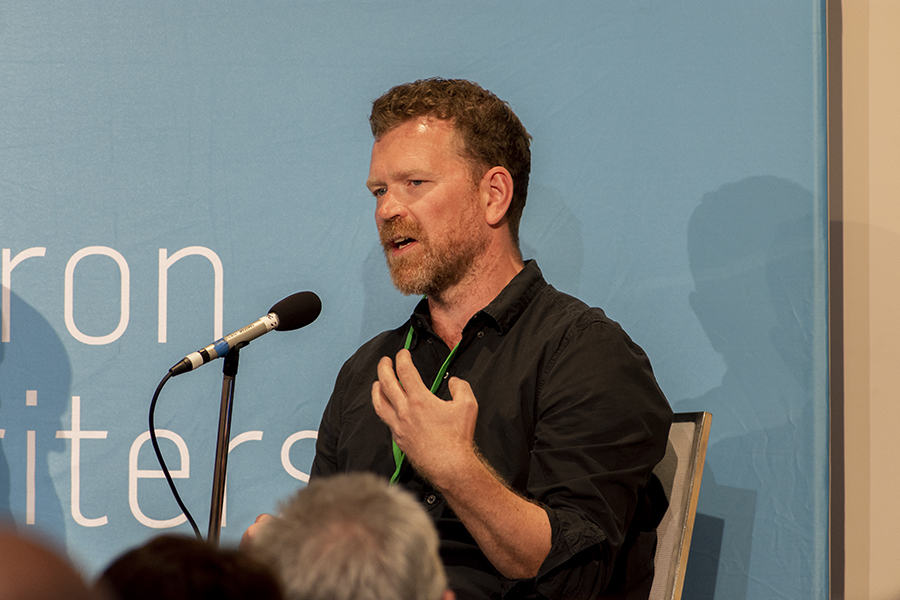Chasing Thunder: illegal fishing on the high seas

From the Yellow Brick Road Pavilion, multi-award-winning Norwegian journalists Eskil Engdal and Kjetil Saeter shared their investigation behind their debut book, Catching Thunder: The World’s Longest Sea Chase.
Their real life thriller tracks the immense organisation of crime they discovered operating on the high seas, an organisation they described as very similar to the illegal trafficking of drugs, weapons and humans.
But what was being trafficked was something seemingly insignificant.
The Patagonian toothfish.
As the toothfish is rather slow and stationary, living around seamounts and continental sea-shelves in cold waters in depths between 45 metres and 3.8 kilometres, it can be very easily emptied from its habitat.
Sometimes referred to as ‘white gold’, it is considered a delicacy, tasting somewhere between lobster and scallops.
The journalists’ interest was piqued when Interpol, which normally only searches for individual people, issued a Purple Notice for suspected criminal activity in 2013 for the Thunder.
Originally, the Thunder was part of the Norwegian fleet. It was built in Norway in 1969, but had gone by at least three different names and seven different national flags, most recently a Nigerian one.
By 2006, the Thunder was blacklisted by the Convention of Conservation of Antarctic Marine Living Resources as a suspected illegal fishing vessel.
But policing crime on international waters difficult, as the flag state of the ship is the country which has jurisdiction over it and the Thunder often flew several.
After the Interpol alert, the two journalists began following the ship’s paper trail.
As session chair Debbie Whitmont, ABC Four Corners journalist, points out with ‘the failure of the law of the sea to do things’, it fell to the militant, environmental organisation Sea Shepherd saw no other option than behaviours such as ramming, in order to stop this plundering.
The Sea Shephard vessel Bob Barker had already begun its hunt for the Thunder when Engdal and Saeter made first contact with its captain, Peter Hammarstedt.
He turned out to be just as ‘dogged’ as them, and directed the two journalists to ‘find the owner’ of the Thunder, whom they began to call ‘Mr. Big’.
But their progress was slow, until the Bob Barker found the Thunder.
Immediately the pirate ship moved into pack ice, ‘a very dangerous operation,’ says Engdal, and attempted to lose the Bob Barker, sailing directly into storms and, at one point, even turning and chasing the Bob Barker.
As the crew of the Thunder wore balaclavas, it was hard to identify them.
But slowly, the Sea Shepherd photographer captured their faces, and with the help of a Spanish imprint on a buoy cut from the Thunder, Engdal and Saeter followed the trail to the Spanish port of Riberia.
They brought the photos into hostile bars and eventually found an ex-Norwegian pizza baker drunk enough to speak to them.
The two journalists then set about reconstructing the crew lists through Facebook, trawling through friends lists and photos.
On this tactic, Saeter jokes, you begin to ‘find more and more icebergs in backgrounds’ of the pictures.
In the meantime, the chase was becoming one of the longest in maritime history, a high seas siege, a game of waiting to see who would run out of food or fuel first.
Hammastedt reportedly told his crew: ‘If it takes two years, I will follow the Thunder.’
Then after 110 days, the Thunder suddenly stopped, the crew donned life-jackets and threw a ladder over the side.
The Thunder was sinking, the crew had scuttled their own ship.
Sea Shepherd would not let them aboard the Bob Barker as they could have been taken over by the fishermen.
Instead, they sent three of their members on board the sinking vessel to gather evidence of the Patagonian Toothfish, other information, and captured everything on their Go-Pro camera.
Among the evidence they brought back was a Post-it note with a phone number.
As Saeter says, ‘the devil is in the details’ as it was this number that launched their investigation across the world to find the ‘smoking gun’ – Mr. Big.
What they found in their dead ends, ‘hopeless situations’ and ‘sheer desperation’ was, as Engdal says, a realisation that the crew members were not evil greedy people like Mr. Big.
Most had been pushed into piracy and illegal fishing as their local fisheries were put out of business by other illegal fishing operations, and as their country’s fishing rights were sold off internationally for a pittance, leaving them with nothing.
‘It’s a dirty, dirty business,’ says Saeter. But at least we ‘know a lot more about these operations now’.
And as to whether or not they found Mr. Big, Saeter and Engdal aren’t saying. You’ll have to buy the book.
Jade Hurley is a Southern Cross University Creative Writing BA student.
